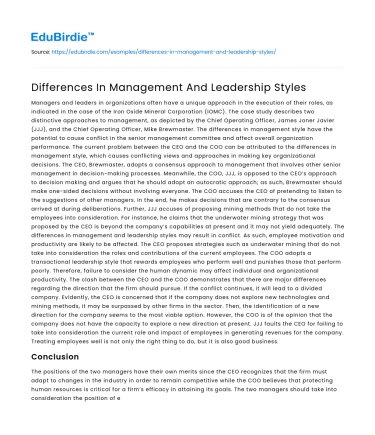Managers and leaders in organizations often have a unique approach in the execution of their roles, as indicated in the case of the Iron Oxide Mineral Corporation (IOMC). The case study describes two distinctive approaches to management, as depicted by the Chief Operating Officer, James Joner Javier (JJJ), and the Chief Operating Officer, Mike Brewmaster. The differences in management style have the potential to cause conflict in the senior management committee and affect overall organization performance.
The current problem between the CEO and the COO can be attributed to the differences in management style, which causes conflicting views and approaches in making key organizational decisions. The CEO, Brewmaster, adopts a consensus approach to management that involves other senior management in decision-making processes. Meanwhile, the COO, JJJ, is opposed to the CEO’s approach to decision making and argues that he should adopt an autocratic approach; as such, Brewmaster should make one-sided decisions without involving everyone. The COO accuses the CEO of pretending to listen to the suggestions of other managers. In the end, he makes decisions that are contrary to the consensus arrived at during deliberations. Further, JJJ accuses of proposing mining methods that do not take the employees into consideration. For instance, he claims that the underwater mining strategy that was proposed by the CEO is beyond the company’s capabilities at present and it may not yield adequately.
Save your time!
We can take care of your essay
- Proper editing and formatting
- Free revision, title page, and bibliography
- Flexible prices and money-back guarantee
The differences in management and leadership styles may result in conflict. As such, employee motivation and productivity are likely to be affected. The CEO proposes strategies such as underwater mining that do not take into consideration the roles and contributions of the current employees. The COO adopts a transactional leadership style that rewards employees who perform well and punishes those that perform poorly. Therefore, failure to consider the human dynamic may affect individual and organizational productivity. The clash between the CEO and the COO demonstrates that there are major differences regarding the direction that the firm should pursue. If the conflict continues, it will lead to a divided company.
Evidently, the CEO is concerned that if the company does not explore new technologies and mining methods, it may be surpassed by other firms in the sector. Then, the identification of a new direction for the company seems to the most viable option. However, the COO is of the opinion that the company does not have the capacity to explore a new direction at present. JJJ faults the CEO for failing to take into consideration the current role and impact of employees in generating revenues for the company. Treating employees well is not only the right thing to do, but it is also good business.
Conclusion
The positions of the two managers have their own merits since the CEO recognizes that the firm must adapt to changes in the industry in order to remain competitive while the COO believes that protecting human resources is critical for a firm’s efficacy in attaining its goals. The two managers should take into consideration the position of each other and consider developing a strategy that integrates their views. If they can work together to build the company’s future, it is possible for both to be satisfied, and each of their views regarding the firm’s future will be taken into consideration in determining the optimal course of action. If the dispute between managers are not mediated, they may have unexpected outcomes including other competing firms taking advantage of the situation.






 Stuck on your essay?
Stuck on your essay?

